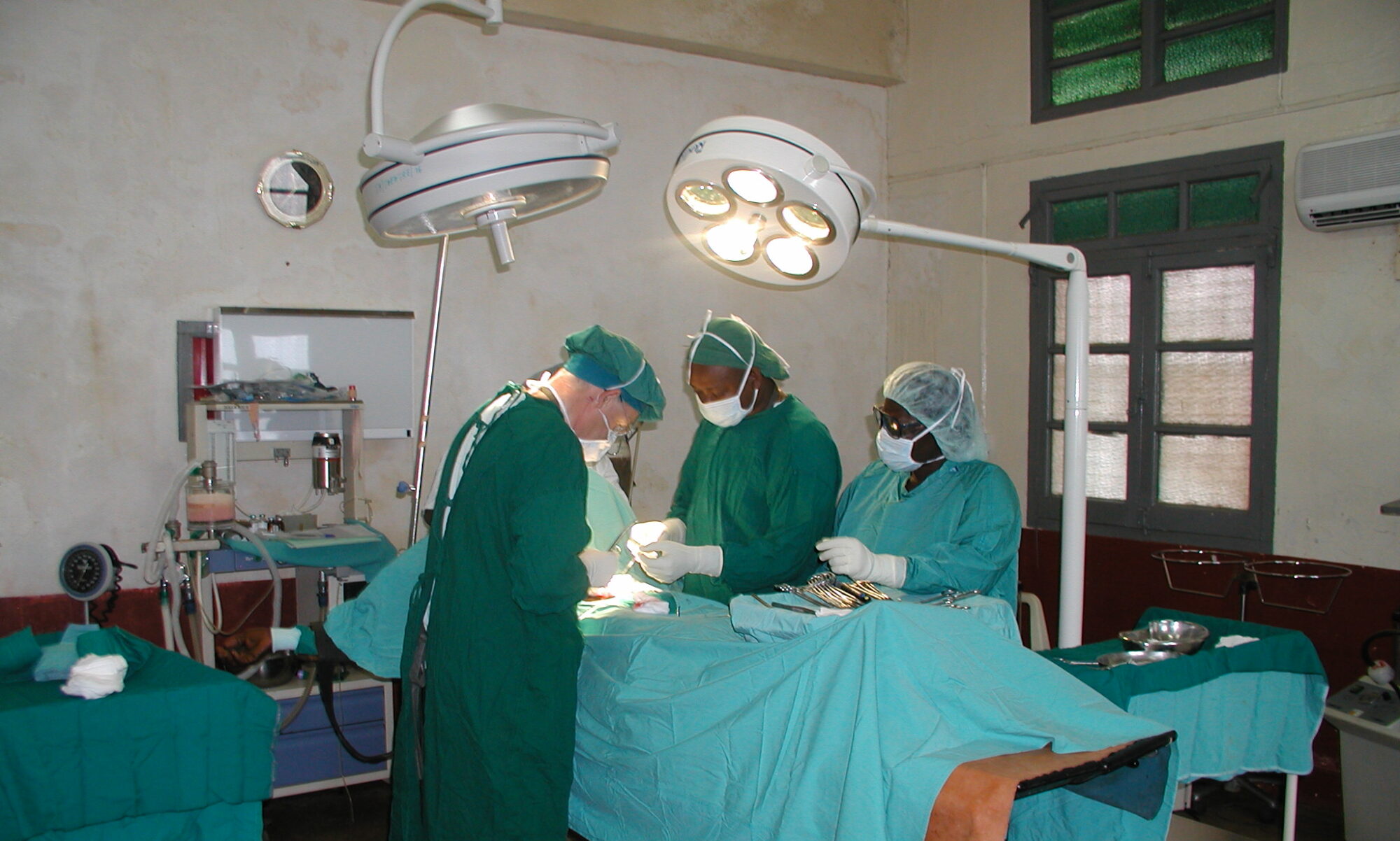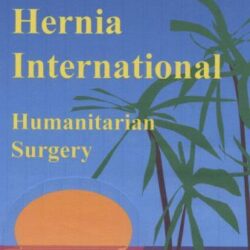HERNIA INTERNATIONAL MISSION
Austrian-Swiss-Liechtenstein-Slovenian Team Mission 2023
Ngarenairobi Tanzania, Oct. 28th-Nov 5th, 2023

The Ngarenairobi Health Centre (NHC)in Siha District in Tanzania hosted a Hernia International Mission for the second time. Again, it was organized by the Congregation of Spiritus Sancti Fathers (ALCP OSS), especially Father Damian, who has similar organization skills as Rev. Sister dr. Avelina Temba in Korogwe. On the other side, the organizer was Dr. Gorjanc from Krankenhaus der Elisabethinen in Austria. Our Tansanian surgical and anaesthesiological friends dr Kombo, dr. Joseph, dr. Cosiano, Fanuel and others were again helpful in preparing enough patients for a successful mission.
The travel from our homes to NHC took us 12-24 hours, according to flight connections. Michael, Katalin and Wolfgang are not just skilled anaesthesia team but also keen mountaineers and summited Mt. Meru Mountain (4566m) in the days before the mission. Some members of the team were on Zanzibar island on deserved holidays just before the mission.
We all met on Sunday on October 29th at the Provincial house of the Congregation and from there and back we were transported to the NHC daily (about 30 min one way by minibus). Our team consisted of 12 members: 3 surgeons-consultants, 1 plastic and reconstructive surgeon, 2 anaesthesiologists, 1 radiologist, 2 scrub nurses, 1 nurse anaesthetist, 2 medical students (one from Mwanza, Tanzania).
Additionally, 4 local doctors from Tanzania were present on different days of the mission. We imported 300 kg of medical equipment and drugs in 15 bags. Again, there were no difficulties at the customs due on-time application of our gear at the TMDA (Tanzanian Medicine & Medicine Devices Authority), but still additional help of father Damian was required at customs of the entry airport (Kilimanjaro) for some of us.Checking patients for surgery was our first task on sunday evening and monday morning. There were more patients than the year before. There were many thyroid patients, we operated on all who were euthyrotic. The turnover of the patients was fluent.
Parallel operations on 2 and sometimes 3 tables, enabled 57 procedures on 54 patients in 5 days. Twelve patients were children (22%) and 42 were adults (78%). 31 patients (57%) were female. The most frequent operations were hernia repairs (inguinals, umbilicals and epigastrics), followed by thyroid resections, lipoma excisions, Jaboulay`s (Winkelmann) procedure for hydrocaele operation and other smaller operations (one orchidopexy due to undescended testicle in child. Other diagnoses/operations were operations for benign lesions and other smaller excisions. In inguinals in children, Mitchell-Banks repair was performed and Lichtenstein repair with LDPE mesh was performed in adult patients with inguinal hernia. The youngest patient was 3 years old. Thanks to the excellent anaesthesia team and Ligasure device (which we brought with us) we performed 6 subtotal goiter resections in big benign goiters and unfortunately had to cancel 4 more due to untreated hyperthyrosis. All resected thyroid glands were histologically examined (costs are 30$/specimen in Tanzania). The resections were subtotal in order not to demand postoperative hormone substitution. In case, this might still be necessary at T3/T4 check in 3 months, it will be provided (in Tanzania costs for oral Levothyroxine are 20 $/month/patient). Maria performed 58 ultrasound examinations with her potable US (32 in women, 26 in men). She did the interpretation of abdominal X-ray in a patient with acute abdominal pain and in a patient with hand problem. Again, ultrasound enabled exact diagnosis in many patients and made many decisions easier. In patients with goiter this was the only way to plan the exact extent of the resection.





In OT 1 (good lights, diathermy which we brought last year is working), mainly general anaesthesia was performed, while procedures in OT2 (head lamps, diathermy) were first spinal anaesthesia, but then our anaesthesia team used a mobile respirator that they brought along (Oxylog 3000) for general anaesthesia. In OT 3 (improvised from recovery room), we used head lamps and local anaesthesia and did not have diathermy available.
Scrub nurses Manuela and Sofi prepared tables and selected instruments and material in 3 Ots. Manuela is experienced from many missions and always scrubbed in for thyroid operations. HI- missions with possible large/complex hernia- and other operations should always have an experienced scrub nurse in the team.
Lea as plastic surgeon together with Christoph mastered some reconstructive surgeries (contractures) after burns and performed many aesthetic excisions of skin disorders.
We had one postoperative haemathoma after lipoma excision – it was evacuated surgically on the same evening. Again, we took enough time for every single procedure, without hurrying, which was important in all and not only in HIV-positive patients. A normal working day started at 8 am and ended at 4-6 pm. Normally, after a good breakfast we did not take lunch break (some biscuits, soft drinks, coffee and tea were sufficient between operations). We all met every day again at dinner at 7pm.



Team Members:
Dr. Michael Wirnsperger – consultant anaesthesiologist, LKH Bludenz, Austria
Dr. Katalin Wiese-consultant anaesthesiologist, Krankenhaus Feldkirch, Austria
Wolfgang Walser – anaesthesia nurse, Feldkirch, Austria
Dr. Marija Jekovec – consultant radiologist, Ljubljana Medical Centre, Slovenia
Manuela Logan, scrub nurse, Liechtenstein
Prof. Mirko Omejc, MD, PhD – consultant surgeon, Ljubljana Medical Centre, Slovenia
Andrej Omejc – medical student, Ljubljana, Slovenia
Edward Edmund – medical student, Mwanza, Tanzania
Dr. Christoph Sträuli, MD-consultant surgeon Grabs, Switzerland
Dr. Lea Lisborg Mračević – resident plastic and reconstructive surgeon
Assist. prof. Jurij Gorjanc, MD, PhD, FRCS, FEBS AWS – consultant surgeon, team leader, Krankenhaus der Elisabethinen Klagenfurt, Austria
Our sponsors:
Krankenhaus der Elisabethinen Klagenfurt
Medical Center Gorjanc
Implantoloski institut / Implant Institute
LKH Bludenz
LKH Feldkirch
Spital Grabs
Kirurgija Bitenc
University Medical Centre Ljubljana
Medtronic Austria
Dahlhausen
Gynäkologie Dr. Alberer, Klagenfurt


